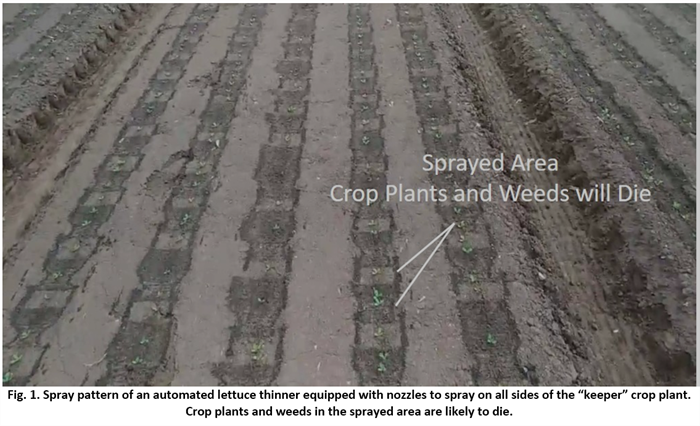Jul 22, 2020
Automated Lettuce Thinner Effects on Weed Control
Vegetable season is rapidly approaching, and it won’t be long before established stands of lettuce are ready to be thinned. Since their commercialization about 8 years ago, use automated lettuce thinning machines has become a common practice in the Yuma area. These machines intermittently spray solutions of herbicide or fertilizer in the plant row to kill excess seedlings. A question growers might have is whether or not automated lettuce thinning is also effective at controlling in-row weeds. Research studies have shown it is.
In trials conducted in 2014 and 2015, Mosqueda et al. (2017) compared the performance of four different automated thinning machines with hand thinning. Eight commercial field sites near Salinas, CA were utilized in the study. Results showed that automated thinning and hand thinning removed 68% and 73% of the weeds respectively (percentage data provided in Smith, 2015). The differences were not statistically significant, implying that automated thinning was as effective at in-row weed removal as compared to hand thinning.
It’s interesting to note that both thinning methods controlled essentially all in-row weeds except those close to the “keeper” crop plant. To make this conclusion, one can estimate the percentage of the seed line that was sprayed or hoed by using the target plant spacing of 11” and assuming that a 1.5” safety/buffer distance was used on either side of the keeper crop plant. Given these parameters, the percentage of in-row area that was not sprayed or hoed out can be calculated as ((1.5 + 1.5)/11 x 100), or 27%. The sprayed or hoed out area is 100% minus this value, or 73%. This value compares very favorably to the 68-73% weed control efficacy found by Mosqueda et al. (2017).
Automated thinner manufacturers offer an option where spray is also applied to the sides of the keeper plant relative to the direction of travel. The concept is to control as many weed as possible near the crop plant. An example of the spray pattern described is shown in Fig. 1. Given the demonstrated high efficacy of spray solutions used for automated thinning, this technique may be an option worth considering for the upcoming growing season as weeds close to the crop plant are the most difficult and time consuming to control.

References:
Mosqueda, E., Smith, R., Goorahoo, D. & Shrestha, A. Automated lettuce thinners reduce labor requirements and increase speed of thinning. California Agriculture, 72(2):114-119.
Smith, R. Impact of automated thinners on weeds and lettuce production. In Proc. 67th Annual California Weed Science Society 67: 44. Salinas, Calif.: California Weed Science Society.
To contact Mark C. Siemens go to:
siemens@cals.arizona.edu











